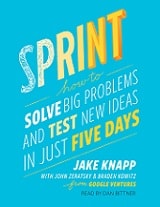[greybox]
 A review of
A review of
Sprint: How to Solve Big Problems and Test New Ideas in Just Five Days
Simon & Shuster
About this book
by Jake Knapp
A good reference for Methods/How-To
Primary audience: Designers or Technical Roles who are new to the topic or have some experience with the topic
Writing style: Humorous/light; matter of fact
Text density: Mostly text
Learn more about our review guidelines
[/greybox]
Whether you work in a small startup or a large corporation, teams can work on a solution for months to years only to produce products or services that fail to meet customers’ needs.
Sprint: How to Solve Big Problems and Test New Ideas in Just Five Days provides a blueprint for how to solve for large-scale problems in a short amount of time. Author Jake Knapp is a self-professed “process geek” and design partner at Google Ventures (GV), where he ran hundreds of design sprints for a diverse range of companies, including Blue Bottle Coffee, Flatiron Health, and Slack. Through his own successes and failures, he shares a wealth of recommendations on how to run your own design sprint.
Preparing for Your Sprint
The first few chapters introduce the concept of a design sprint and go over which challenges to tackle, which team members to include, and the logistics involved before starting a sprint. The book recommends that the problems to solve for during a sprint should be problems that would potentially require a lot of money and time, problems that don’t have enough time to be solved for, or problems that your team is “just plain stuck” on.
The book also stresses the importance of having a diverse group of stakeholders who are experts in their relevant fields, including a key decision maker, or “decider,” as well as people in finance, marketing, customer support, tech, and design.
Conducting Your Sprint
Once the team is assembled and logistics are determined, it’s time to conduct the sprint. The book includes a day-by-day task breakdown for a Monday to Friday schedule:
- Monday: The first day is dedicated to figuring out what challenge(s) your team wants to solve for, creating a customer-centered map that outlines what the overall problem is, and interviewing the experts on your team about what they know.
- Tuesday: After figuring out your problem, you will be brainstorming potential solutions with your team. You will sketch out ideas individually and then present to the team.
- Wednesday: With your new ideas from the previous day, your team will share all the sketches and vote on your favorites. Once the top ideas are selected, your team will refine and flesh them out by creating a customer-centered storyboard that documents the end-to-end experience for a user.
- Thursday: Once the storyboard is finalized, a prototype that the team can give to customers for feedback should be created. Specific roles should be assigned to each team member to divide and conquer, and a test run should be done once the prototype is in a workable state.
- Friday: On the last day, test out the prototype with real customers. The book recommends testing with five customers and recording feedback so your team can see the results. After the testing is analyzed and results compiled, the team can decide whether or not the prototype requires further refinement or development.
The book also comes with a companion website that includes video overviews for each of the days of the sprint.
Overall, Sprint is a great practical guideline for practitioners who want to get their hands dirty on conducting a design sprint. I found the book to be engaging with many real-life narrative examples of GV’s prior sprints coupled with easy to follow tips and tricks that would be useful for beginners. In conclusion, I would highly recommend this book for product teams and tech practitioners who are hoping to get a foundational understanding of how to conduct design sprints.
[bluebox]
Sketch
Serah Giarusso, Blue Bottle Coffee’s customer support lead, looked uneasy. And she wasn’t the only one. James Freeman, the CEO, furrowed his brow.
It was Tuesday afternoon of Blue Bottle’s sprint. Sunlight made rectangles on the carpet. Somewhere on the street below, a car honked. And there, in the middle of the sprint room, on a coffee table, was the source of the team’s consternation: a stack of paper, a dozen clipboards, and a paper cup filled with black pens.
Somebody cleared his throat. It was Byard Duncan, Blue Bottle’s communications manager. As everyone turned, he cracked a sheepish smile.
“So…,” he said. “What if I can’t draw?”
[/bluebox]
You can also see a 90-second intro video from the Sprint website.
